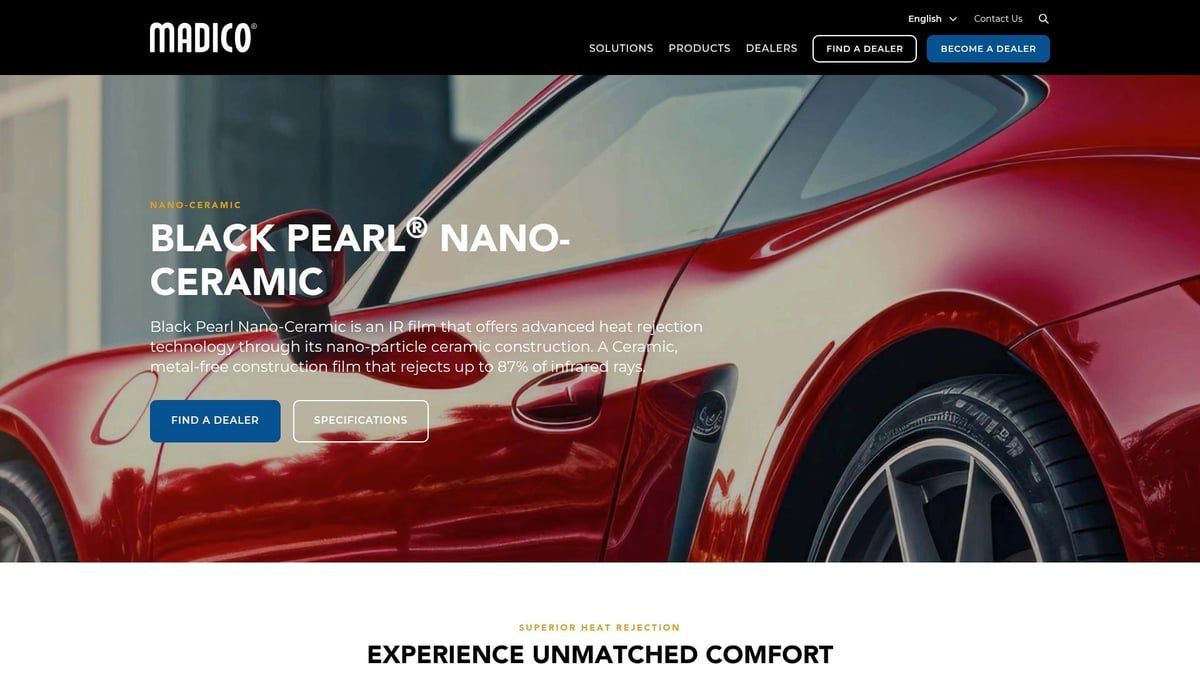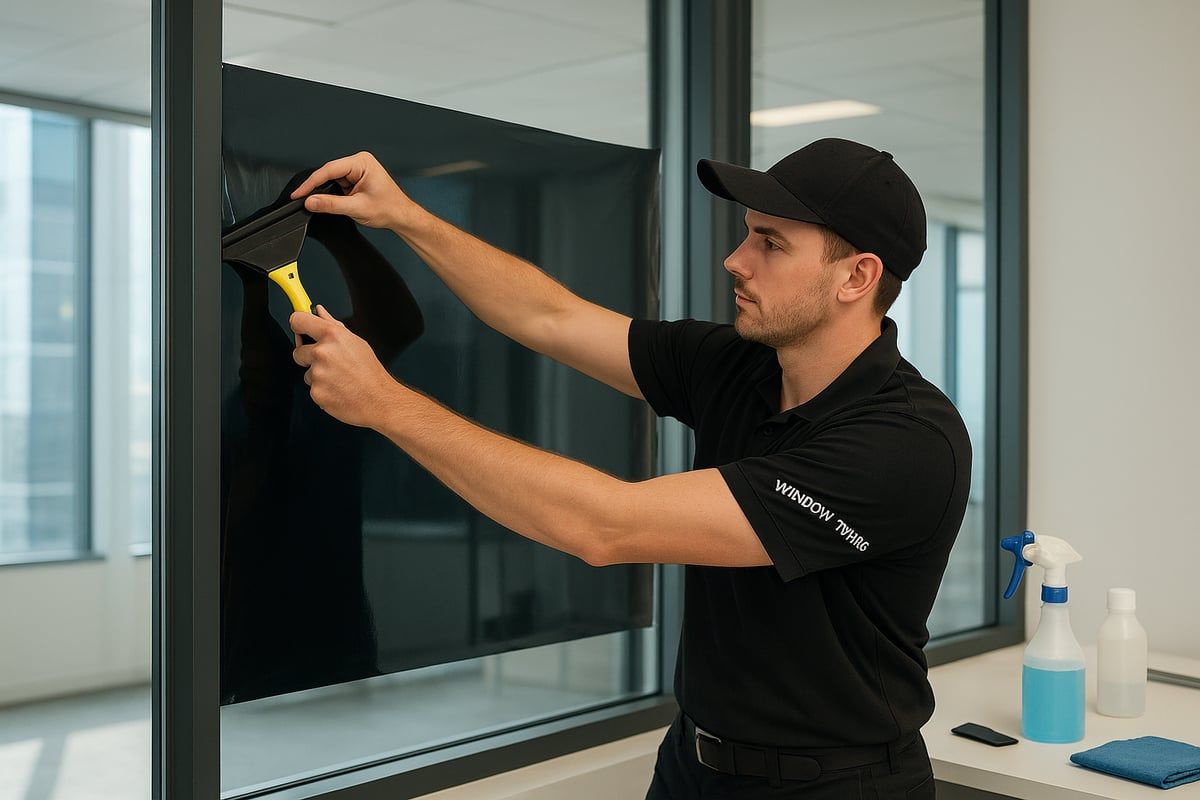Expert Guide to Tint a Window for Home and Auto in 2025
Expert Guide to Tint a Window for Home and Auto in 2025
Window tinting has evolved rapidly in 2025, offering significant advantages for both homeowners and drivers. If you want to tint a window, it is no longer just about enhancing looks, but about improving energy efficiency, privacy, and protection for your property and vehicle.
This expert guide will walk you through the latest films, tools, and methods to tint a window with confidence. You will learn about new trends, compare film types, follow step-by-step installation, understand legal guidelines, and get maintenance tips for lasting results.
Ready to achieve greater comfort, savings, and security? Let’s dive in.
Why Tint Windows in 2025? Benefits and Trends
Window tinting in 2025 is about far more than just darkening glass for style. When you tint a window today, you unlock a suite of benefits that blend comfort, efficiency, and protection for both your home and vehicle. Let’s explore why more people are choosing to tint a window and how the latest trends are shaping the industry.
Enhanced Energy Efficiency
One of the most compelling reasons to tint a window in 2025 is the significant boost in energy efficiency. Modern window films can reduce cooling costs by up to 30%, making them a smart investment for both homeowners and drivers. By reflecting and absorbing solar heat, tinted windows keep indoor temperatures stable, reducing the need for air conditioning. According to Sun Control Window Tint Benefits, today’s advanced films are engineered for maximum energy savings while maintaining clarity and style.
Maximum UV Protection
When you tint a window, you are also safeguarding your family and interior spaces. High-quality films block up to 99% of harmful UV rays, which helps preserve furniture, flooring, and automotive interiors from fading. More importantly, this level of UV defense protects skin from prolonged sun exposure, reducing health risks for everyone inside your home or vehicle.
Privacy and Security Advantages
Privacy is a growing concern in 2025, and window tinting offers a practical solution. Reflective and privacy films make it difficult for outsiders to see in, giving you peace of mind. For added safety, security films reinforce glass, making break-ins more challenging. When you tint a window with these advanced options, you also reduce the risk of theft and vandalism, especially in urban environments.
Key Benefits Table
Benefit Home Auto Energy Savings Up to 30%Up to 30%UV Protection Up to 99%Up to 99%PrivacyHighModerate to High Glare Reduction Excellent Excellent Aesthetic Choices Wide Variety Wide Variety
Aesthetic Upgrades and Glare Reduction
When you tint a window, you enhance the look of your property or vehicle. Tints are now available in a range of shades and finishes, from subtle neutrals to bold mirrored effects. This customization not only boosts curb appeal but can also increase property value. In addition, tinted windows drastically reduce glare, making reading, screen use, and driving much more comfortable.
Trends: Smart, Ceramic, and Eco-Friendly Films
The industry continues to innovate, and 2025 brings exciting new options. Smart tints and electrochromic films let you adjust tint levels with the touch of a button, offering on-demand privacy or sunlight control. Ceramic films deliver top-tier heat and UV rejection without interfering with electronics. Eco-conscious consumers can now tint a window using biodegradable or recyclable materials, reflecting a shift toward sustainability.
Health Impact and Real-World Satisfaction
Families and drivers report fewer headaches, less eye strain, and increased comfort after they tint a window in their homes or vehicles. Reducing sun exposure also helps lower the risk of skin damage. Case studies highlight homeowners enjoying cooler rooms and drivers appreciating longer-lasting interiors. The satisfaction rate remains high, especially as window tinting becomes more advanced and accessible.
Tint a window in 2025, and you gain more than just style. You embrace a future of energy savings, safety, and comfort, all while keeping up with modern trends and technology.
Choosing the Right Window Tint: Types, Features, and Selection Criteria
Selecting how to tint a window in 2025 involves understanding film types, application differences, and what matters most for your space or vehicle. With advanced films and evolving standards, making the right choice means balancing technology, aesthetics, and performance.
Types of Window Tint Films
Choosing the right material is the foundation when you tint a window. Each film type offers distinct benefits and limitations.
- Dyed Films: These are budget-friendly and provide basic heat and glare reduction. They are popular for those new to tint a window but may fade over time.
- Metalized Films: Infused with metallic particles, these films enhance durability and heat rejection. However, they can interfere with electronic signals, which is important to consider if you tint a window on modern vehicles or smart homes.
- Ceramic Films: These tints use nano-ceramic technology for superior heat, UV, and glare control. They do not disrupt electronic devices and are a top choice for those seeking to tint a window in luxury cars or energy-efficient homes.
- Carbon Films: Highly fade-resistant, carbon films offer strong insulation and do not turn purple over time. Their matte finish is preferred for a subtle, stylish look.
- Smart/Electrochromic Films: These advanced options allow you to tint a window with adjustable opacity, controlled by a switch or automation system.
- Reflective/Mirrored Films: Designed mainly for residential use, these films maximize privacy and solar rejection.
- Static Cling vs. Adhesive Films: Static cling films are great for DIY projects and temporary needs, while adhesive films offer longer-lasting results and a more professional finish.
With so many options, understanding these types is essential before you tint a window for your home or vehicle.
Comparing Tint for Home vs. Auto Applications
When you tint a window, your approach will differ based on whether it’s for a house or a car. Homes often prioritize energy savings, privacy, and UV blocking, while vehicles focus on visibility, legal compliance, and protecting interiors.
Feature Home Tinting Auto Tinting Main Goals Energy efficiency, privacy, UV block Visibility, compliance, interior Film Thickness Usually thicker for durability Thinner, flexible for curvesLifespan10-20 years5-10 years Aesthetics Match décor, subtle or mirrored Match car style, often darkerSafety/Security Ballistic/security options Shatter resistance, theft deterrent
Safety and security films are often chosen for schools, businesses, and high-security homes. When you tint a window in a luxury vehicle or modern home, ceramic films are favored for their clarity and performance. Industry data from 3M shows ceramic films can block over 99% of UV rays and significantly reduce heat, making them an ideal upgrade for both environments.
How to Choose the Best Tint for Your Needs
To effectively tint a window, start by assessing your climate. Hot, sunny regions benefit most from films with high heat rejection, while colder climates may prioritize insulation.
Define your main goals: Are you seeking privacy, security, energy savings, or a specific look? Legal restrictions are crucial, especially for vehicles. Check VLT (Visible Light Transmission) limits for autos and any HOA rules for homes. Compatibility with your existing glass is also important—some films work better on tempered or laminated windows.
Consider warranty and lifespan. Top brands in 2025 offer warranties ranging from 5 to 15 years, depending on film type. Budget plays a role, but investing in quality pays off over time if you plan to tint a window for lasting benefits.
When security is a priority, explore specialized options like Safety and Security Window Films for homes and businesses. While many homeowners and drivers choose DIY kits, consulting a professional ensures compliance, optimal performance, and peace of mind for complex projects.
Balancing all these factors will help you confidently tint a window to meet your needs and maximize value.
Step-by-Step Guide: How to Tint a Window for Home and Auto
Tint a window with confidence in 2025 by following this comprehensive guide. Whether you are working on your home or your vehicle, proper preparation and attention to detail are crucial for a flawless finish. This process not only enhances appearance but also delivers real benefits in energy efficiency, privacy, and protection.
Preparation and Safety Precautions
Before you tint a window, assemble all necessary tools to streamline your workflow. Typical tools include:
- Window tint film
- Squeegee
- Utility knife with extra blades
- Spray bottle filled with application solution (water with a few drops of baby shampoo)
- Lint-free cloths
- Heat gun (essential for curves in auto glass)
- Gloves and protective coverings for surrounding areas
Begin by cleaning the window thoroughly. Any dust, debris, or fingerprints can cause imperfections or reduce film adhesion. Use a lint-free cloth and a gentle cleaner to wipe down the glass surface. For best results, repeat the cleaning process twice.
Measure your window accurately before you tint a window. Cut the film slightly larger than the glass to allow for precise trimming. Lay out protective coverings on floors, dashboards, or window frames to prevent accidental damage from tools or solution overspray.
Safety is paramount when you tint a window. Always wear gloves to protect your hands from sharp blades and chemicals. Work in a well-ventilated area. Avoid installing tint in extreme temperatures or high humidity since these conditions can affect film adhesion and curing.
Common mistakes include rushing the cleaning step, which leads to trapped debris, or trimming the film too small. To see finished projects and understand the difference proper prep makes, browse the Window Tinting Project Gallery for real-world examples.
Applying Tint to Home Windows: Step-by-Step
To tint a window in your home, follow these detailed steps for professional results:
Step 1: Generously spray the window with application solution. This helps the film slide into position and prevents premature sticking.
Step 2: Carefully peel the protective liner from the tint film. Avoid touching the adhesive side to reduce fingerprint marks or dust.
Step 3: Position the film onto the wet glass, adhesive side facing the window. Start at the top and let the film fall naturally, minimizing creases.
Step 4: Using a squeegee, work from the center outward to remove air bubbles and excess solution. Use overlapping, firm strokes to ensure a smooth application.
Step 5: Trim the excess film along the window edges with a sharp utility knife. Hold the blade at a low angle for precision and safety.
Step 6: Inspect the film for remaining bubbles or lifted edges. Re-squeegee as needed, focusing on the corners and perimeter.
Step 7: Allow the film to cure undisturbed for at least 48 hours. Do not touch or clean the surface during this period to prevent shifting.
- When you tint a window with large panes, have a second person assist to prevent the film from folding or sticking to itself.
- For corners and window locks, use a heat gun to gently soften the film, making it more pliable and easier to contour.
- Static cling films are easier for DIYers, as they are repositionable and less messy than adhesive-based options.
Remember, patience is key. Rushed installations often result in bubbles or misaligned film. Take your time for a seamless, long-lasting finish.
Applying Tint to Auto Windows: Step-by-Step
Tint a window in your car with precision by following these automotive-specific instructions:
Step 1: If needed, remove door panels to gain full access to the glass. This step ensures an edge-to-edge fit for the tint film.
Step 2: Clean the glass meticulously using a lint-free cloth and non-ammonia cleaner. Even minor residue can cause adhesion issues.
Step 3: For curved windows, pre-shape the film using a heat gun. Hold the film against the outside of the glass, apply gentle heat, and smooth out wrinkles to mimic the window’s contour.
Step 4: Spray the inside of the window with application solution. Carefully position the film, adhesive side against the glass, aligning it with the top edge.
Step 5: Squeegee out air bubbles, starting from the center and working toward the edges. Pay extra attention near defroster lines and window sensors, as these areas can trap air.
Step 6: Trim the film precisely along window contours using a sharp blade. Smooth cuts are essential for a factory-finished look.
Step 7: Reinstall any removed door panels and inspect the tint for flaws or lifting edges. Minor adjustments can be made with a heat gun and squeegee.
- Rear windshields often have complex curves. Tint a window in this area by using a larger film sheet and applying more heat for flexibility.
- When working around defroster lines, avoid scraping the film to prevent damage.
- Allow the tint to cure for several days before rolling down windows or cleaning.
A methodical approach helps you avoid creases, bubbles, and misalignments. Take your time and follow each step closely for optimal results.
Troubleshooting Common Issues
Even if you carefully tint a window, issues can arise. Here’s how to address the most common problems:
Air Bubbles and Creases
- Cause: Trapped air or improper squeegee technique
- Solution: Re-squeegee problem areas, or use a pin to gently release trapped air, then smooth with a squeegee
Peeling or Poor Adhesion
- Cause: Insufficient cleaning or low-quality film
- Solution: Remove the affected section, clean thoroughly, and reapply with fresh film
Dust or Debris Under Film
- Cause: Incomplete cleaning before installation
- Solution: Lift the film edge, remove debris with tape, and reseal by squeegeeing
Edge Lifting
- Cause: Excess moisture, poor trimming, or working in high humidity
- Solution: Dry the area with a heat gun and press down edges firmly
Color Fading or Purpling
- Cause: Use of low-grade tint film
- Solution: Replace with high-quality, UV-resistant film
Learning from real experiences can help you avoid pitfalls when you tint a window. If persistent problems occur, consulting a professional installer is recommended to ensure the best outcome.
Legal, Safety, and Warranty Considerations for Window Tinting in 2025
Navigating the legal, safety, and warranty landscape is essential when you tint a window in 2025. Regulations and requirements have evolved, making it important to stay informed and compliant whether you are working on your home or vehicle.
Understanding Legal Requirements and Compliance
Before you tint a window, you must check local and federal regulations. Residential and automotive tinting laws focus heavily on visible light transmission (VLT) percentages. For vehicles, states have specific VLT limits for each window, and exceeding these can result in fines or required removal. Homeowners may also face restrictions, especially in HOA-governed communities.
To ensure compliance, always verify the latest legal requirements for your area. You can easily reference the 2025 Window Tint Laws by State for up-to-date information on VLT percentages and restrictions. This step is crucial before you tint a window, as legal standards can change annually and differ by location.
Some regions require certification labels on installed films. Stay vigilant for recent updates, as law enforcement has increased spot checks and enforcement in many states, particularly for dark tints on vehicles.
Safety Standards and Certifications
When you tint a window, prioritize safety and quality. Look for films certified by the National Fenestration Rating Council (NFRC) or the International Window Film Association (IWFA). These certifications ensure that the tint meets performance and safety benchmarks for UV protection, durability, and energy efficiency.
Table: Common Safety Certifications
Certification Applies To Ensures NFRC Residential/Auto Energy, UV, VLT IWFA Residential/AutoSafety, performance ANSI Z97.1Safety/Security Impact resistance
Specialty films, such as ballistic or shatter-resistant options, must meet additional safety standards. Schools, businesses, and homeowners seeking extra security should request documentation of compliance before installation.
Warranty, Insurance, and Staying Up to Date
Leading brands offer warranties ranging from 5 to 15 years, covering fading, peeling, and bubbling. The warranty specifics often depend on the type of film and whether a professional or DIY method was used to tint a window. Always read the fine print and keep documentation for future claims.
Tinting your windows may impact your auto or home insurance. Some providers require proof that your tint a window project meets legal standards, while others may offer discounts for security or energy-saving films.
To stay current, consult industry resources and certified installers. They can help you interpret warranty terms, understand your insurance implications, and ensure every tint a window installation is both safe and legal.
Maintenance, Care, and Longevity of Window Tint
Proper maintenance is essential to ensure you get the best performance and appearance when you tint a window. With the right care, modern window films can last for years, delivering energy savings, UV protection, and lasting style.
Cleaning and Avoiding Scratches
After you tint a window, use only soft, lint-free cloths and ammonia-free cleaners. Harsh chemicals or abrasive pads can damage the film’s surface, causing scratches or cloudiness.
Safe cleaning products include:
- Diluted dish soap and water
- Commercial window film cleaners
- Microfiber towels
Avoid razor blades or rough sponges. Clean gently, and always spray cleaner onto the cloth, not directly on the glass, to prevent liquid from seeping under the film.
Curing Period and Early Care
Immediately after you tint a window, the film requires a curing period. This usually lasts from a few days to a week, depending on climate and film thickness.
During curing:
- Do not roll down auto windows or open sliding panes.
- Avoid washing or touching the film.
- Expect some haziness or water bubbles, which should disappear as the adhesive sets.
Patience is key. Premature cleaning or handling can cause peeling or bubbles, shortening the lifespan of your window film.
Signs of Wear and When to Replace
Over time, even the best films show signs of wear. Look for:
- Bubbling or peeling along edges
- Fading or color changes (especially purple tint in low-quality films)
- Persistent haze or scratches
When these issues appear, it’s time to replace or repair the film. Real-life experiences shared in Customer Reviews on Window Tinting highlight how proper care can extend film life and keep your investment looking sharp.
Maximizing Lifespan and Environmental Factors
To maximize the benefits when you tint a window, protect your film from harsh elements. Excessive sun exposure can accelerate fading, while humid environments may affect adhesive strength.
Tips for longer performance:
- Park vehicles in shade or use blinds on home windows.
- Regularly check for edge lifting or debris.
- Schedule routine inspections if you live in extreme climates.
The table below summarizes average film longevity from top brands:
Film TypeAverage Lifespan (Years)Dyed3-5Metalized5-8Ceramic/Carbon8-12Smart/Electrochromic10+
Professional Maintenance vs. DIY Care
Many choose to tint a window themselves, but for best results, professional maintenance is valuable. Certified installers can handle repairs, replace damaged sections, and provide warranties.
For minor cleaning and care, DIY is often sufficient. However, if you notice extensive peeling, discoloration, or persistent bubbles, it’s wise to consult a specialist for assessment and replacement.
Innovations and Future Trends in Window Tinting Technology
Window tinting is transforming rapidly, driven by breakthroughs in science and consumer demand for smarter, more sustainable solutions. As you consider how to tint a window in 2025, it is essential to understand how these innovations can impact your choices, comfort, and investment.
Smart Tinting: The Age of Switchable Films
One of the most exciting trends is the rise of electrochromic and switchable films. These advanced materials allow you to tint a window at the touch of a button, shifting instantly between clear and shaded states. This technology offers on-demand privacy, glare reduction, and can be integrated into smart home or vehicle systems.
Recent research into chiral ferroelectric nematic liquid crystal windows demonstrates how low-power, responsive films are becoming mainstream. For a deep dive into this innovation, see the Low-Power Temperature Control by Chiral Ferroelectric Nematic Liquid Crystal Windows study. Homeowners and EV drivers are already reporting greater comfort and energy savings thanks to these dynamic solutions.
Nanotechnology and Advanced Materials
Nanotechnology is enabling films that block ultraviolet and infrared rays more effectively than ever, without making the glass noticeably darker. When you tint a window with nanotech-enhanced films, you gain protection from heat and harmful rays while maintaining a natural, open feel.
Ceramic and multilayered films are popular for their clarity and performance. These materials are especially valued in luxury homes and vehicles, where visibility and aesthetics are top priorities. Expect to see even more sophisticated options as research advances.
Eco-Friendly and Integrated Solutions
Sustainability is a major focus for those looking to tint a window in 2025. Manufacturers are introducing biodegradable, recyclable, and low-emission films that reduce environmental impact. Many of these products are now ENERGY STAR certified, highlighting their role in cutting energy costs. Explore the ENERGY STAR Certified Windows for detailed data on energy savings.
Integration with smart homes and vehicles is also expanding. Automated systems can adjust tint levels based on sunlight or temperature, creating optimal comfort and efficiency throughout the day.
Security, Market Growth, and Consumer Trends
Security films are getting stronger, with new ballistic and impact-resistant options designed for both residential and commercial applications. As more people prioritize safety, demand for these innovations is on the rise.
Industry data shows the window film market is projected to grow steadily through 2025 and beyond. Consumers want films that do more than simply tint a window—they seek solutions that combine privacy, energy efficiency, and advanced technology. Case studies from modern homes and electric vehicles highlight the growing adoption of multi-functional films, reflecting a shift toward smarter, greener living.
Resources and Expert Support for Window Tinting Projects
Whether you plan to tint a window yourself or hire a professional, having the right resources is crucial. Start by sourcing quality films and installation tools from trusted online retailers, local auto shops, or home improvement stores.
Certified installers can be found through organizations like the IWFA and NFRC, ensuring your tint a window project meets the latest industry standards. Leading manufacturers such as 3M, SunTek, and LLumar offer extensive product support and warranties.
Explore online tutorials, forums, and community groups for step-by-step DIY guidance and troubleshooting tips. For complex or large-scale jobs, consulting a professional is often the best choice to guarantee long-lasting results.
When comparing services, request quotes from multiple providers and verify their credentials. Reputable dealers not only deliver quality but also ensure compliance with regulations, as detailed in the NHTSA Interpretation on Window Tinting.
Now that you understand the latest advances in window tinting for both homes and vehicles—from energy efficiency and UV protection to enhanced privacy and security—you’re ready to take the next step. Whether you’re considering a DIY project or want a professional finish, making the right choice protects your investment and your peace of mind. If you’re looking for trusted expertise and proven solutions, I encourage you to explore your options with Lewolf Window Tint and Film Solutions. You can start your journey toward a safer, more comfortable space—Get Protected Today.






